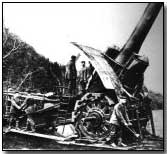Encyclopedia - Big Bertha
 Although the name was
commonly applied to a whole variety of large-calibre German artillery guns
the "Big Bertha" ('Dicke Berta') actually referred to a single
siege gun, at that time the world's largest and most powerful.
Although the name was
commonly applied to a whole variety of large-calibre German artillery guns
the "Big Bertha" ('Dicke Berta') actually referred to a single
siege gun, at that time the world's largest and most powerful.
Produced by the German firm of Krupp the Big Bertha was a 42cm howitzer, model L/14 designed in the aftermath of the Russo-Japanese War of 1904 on behalf of the German Army. It was initially used as a means of (successfully) demolishing the fortress towns of Liege and Namur in August 1914, the war's first month (and subsequently as Antwerp). It was thereafter used to similarly reduce other enemy strong-points as the need arose.
The somewhat unflattering name itself arose from association with the wife of Gustav Krupp, owner of the Krupp factory. Her name was Bertha Krupp von Bohlen und Halbach.
Only four Big Bertha howitzers were produced, the first two rolling off the production line a mere matter of days after the onset of hostilities, on 9 August 1914. Once constructed these huge guns, whose shells weighed 820kg each, were shipped in their constituent parts by tractor to their destination point where they were once again reassembled by a huge crew of as many as 1,000 men.
With a range of 15km their 420mm shells proved devastating and all four were used during the German assault upon Verdun from February 1916.
Once the Verdun offensive was called off in failure (leading to the replacement of German Chief of Staff Erich von Falkenhayn who had initiated the battle) the Big Bertha guns were decommissioned, since Allied artillery developments had resulted in guns with a longer range.
A "Brass Hat" was a high ranking officer.
- Did you know?
